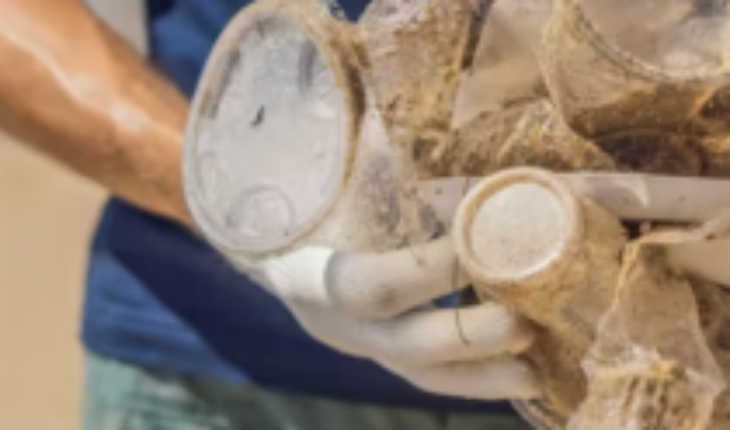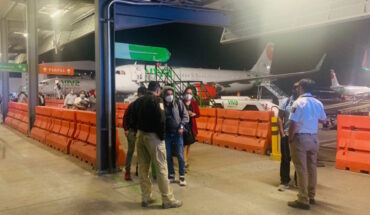Plastic pollution in the oceans has become a global problem. An estimated 14.5 million tons of plastic are dumped into the sea each year.
Over the past few years, numerous platforms have emerged in order to reduce the impact of plastics on nature. But can we consider this a valid solution to the problem generated by the uncontrolled dumping of this waste?
Plastic and its interaction with the ecosystem
The life of plastics does not end once they reach the sea. The presence of some plastic elements, such as fishing tools in the case of ghost fishing, can have a negative effect on the survival of marine ecosystems.
But plastics present in the marine environment can also be used by numerous organisms that need to live fixed to a surface. They may be home to bacteria, polyps, mollusks and other living things that otherwise could not have colonized that space, reforesting an environment that might have previously ravaged.
As with artificial reefs, the presence of these new substrates can encourage the creation of ecosystems that will eventually become more complex, increasing the biodiversity of the area. That is why sometimes its removal from the environment once time has passed and an ecosystem has been created around the waste can generate greater destruction than letting it remain.
To this possible destruction of the environment must be added other factors that hinder the collection of plastic waste, especially in the long term.
A material that loses its integrity
On the one hand, the continuous physical and chemical stress suffered by plastic in the sea causes the fragmentation of macroplastics into micro and nanoplastics, with a diameter of less than 5 mm.
Microplastics, despite their small size, cause numerous negative effects on the marine environment. Its small size makes it almost impossible to detect and recover. In addition, its composition is so varied that its reuse is almost impossible.
Larger plastics are easier to detect, but that is not why we are facing a simple task. Their buoyancy and low weight allow them to travel long distances before reaching new shores. In addition, large areas of accumulation can occur, as is the case on the large island of garbage in the Pacific.
On the other hand, the heterogeneity and loss of quality that these wastes present reduces the possibility that they will be returned to useful life, assuming that we can recover them.
Environmental conditions, climatology and the biological activity of marine microorganisms alter the integrity and chemical composition of plastics. This modification results in a decrease in the quality of plastic as a raw material and, therefore, in a loss of interest on the part of the plastic buyer.
An unprofitable business
The lack of economic profitability in the reuse of recycled marine plastic is one of the main problems facing the industry right now. The problem is that its low economic value leads to the failure to develop the activities necessary to extract it.
To the low quality of the material are added the high costs associated with the collection and cleaning of plastic waste. Plastic from the sea must be “captured” and brought ashore. It is also necessary to clean biological debris or other contaminants that have adhered to its surface.
Currently, efforts are being made to raise awareness and encourage fishermen to dedicate part of their activity to collecting plastics and especially not to return to the sea that plastic collected during the extraction of fish. However, the low profit it brings them makes it difficult to incorporate this economic activity into the sector.
All these factors make a product of lower quality than that of new plastic, already cheaper, and that of the waste that is already in the recycling cycle from its disposal. This is decisive for companies when choosing the raw material for their products. Consequently, plastic continues to be produced instead of recycling or reusing that recovered from the sea.
Today, there are companies that offer products made with recycled or recovered plastic. However, if we look closely at the raw material, it is likely that it does not come from the sea, but has been recovered before being discarded. The purchase of the waste will be made directly to the generator of this, eliminating the costs associated with its recuperation and treatment.
Necessary changes to the current model
It is necessary to develop and promote the valorization of used plastic as a product of use and not as a waste. This would be the best way to prevent it from ending up at sea, since the industry would capture it before it was discarded.
Although there are currently initiatives at European and global level that promote the use of recycled plastic in industry, it is necessary to consolidate the implementation of circular economy practices. Production companies have to incorporate this dynamic of reuse in their production processes. The consumer must demand environmentally sensitive products and be willing to pay a little more for them.
For this, technological advances are necessary to help make more use of the waste already generated, improving production and recycling processes. However, the solutions go beyond technological innovation. Changes in legislation are needed to encourage recycling and reuse, banning actions such as the export of garbage outside the European Union. And beyond politics, it is necessary to promote social practices that help the reuse of plastic in accordance with the principles of the circular economy.
As can be deduced after this analysis, once the plastic reaches the sea, the problem becomes increasingly complex. The longer a waste spends in the ocean, the more likely it is that it will never leave it. However, preventing plastics from arriving requires tackling the problem from different angles, seeking technological, political and social innovations.
Saray Ramírez Rodríguez, Professor and researcher at CREDA/ Department of Agri-Food Engineering and Biotechnology, Universitat Politècnica de Catalunya – BarcelonaTech; David Fernández Guerrero, Postdoctoral researcher, specialized in innovation policy, Universitat Politècnica de Catalunya – BarcelonaTech; Lourdes Reig Puig, Professor-researcher in the Department of Agri-Food Engineering and Biotechnology, Universitat Politècnica de Catalunya – BarcelonaTech; Martín Federico Alba, Research Support Technician at CREDA – UPC – IRTA, Universitat Politècnica de Catalunya – BarcelonaTech and Riccardo Palazzolo Henkes, Research Technician, Universitat Politècnica de Catalunya – BarcelonaTech
This article was originally published on The Conversation. Read the original.
Follow us on





